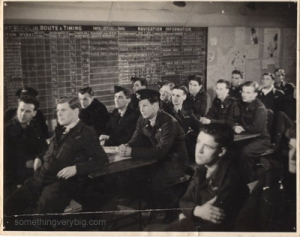While the photograph that is now finding a wider audience as the cover shot of Bomber Command: Failed to Return is the only known image showing the entire crew of B for Baker, there is one more photo that shows at least four of them. It is from the small collection that was with my great uncle Jack’s logbook and it shows a large group of airmen in a briefing room. The three men furthest back in the photograph are, left to right, Ken Tabor, Eric Hill and Gil Pate. In the middle of the second row, next to the man wearing the round officer’s cap, is Phil Smith:
It has been thought that the man in the middle of the row immediately behind Phil Smith was Jack Purcell, on the basis of an arrow that my father says used to be attached to the photo. Certainly Edward Purcell, Jack’s brother and recorded next-of-kin, thought initially that this man was the one who looked most like Jack, writing to Don Smith in November 1944 that:
“The actual features are, as you will notice, very vague, but the general head conformation is identical with that of the boy.” (A01-110-001)
But a month later, after Don had provided another enlarged photo, Edward reconsidered:
“It was most kind of you to send the photos but, I am sorry to say, the enlarged view establishes that the boy marked is definitely not Jack.” (A01-111-001)
The photo has an interesting history. When we first met Phil Smith in 1997, we showed him the print. He turned it over – and immediately recognised his own handwriting on the reverse, naming the three members of his crew sitting at the back of the group. But there is an intriguing inconsistency in the photo. At close inspection, the date on the blackboard at top left reads 11 March. The target is given as Berlin. But in neither Jack’s nor Phil’s logbooks is there an operation recorded on that date – to anywhere, let alone to the ‘Big City’. In fact, neither logbook records any flying of any kind on that day. Perhaps, we thought, the briefing had been for an operation that was subsequently scrubbed.
As it turns out, the real answer is even better. Also appearing in the photo – the man in the centre wearing the officer’s hat – is Dan Conway, an A Flight skipper. After the war he wrote a superb book called The Trenches in the Sky, in which he explained the situation. A film unit was visiting Waddington to take shots for a short feature called The RAAF in Europe. The briefing was staged for the benefit of the cameras and, according to Conway, included “references to tracking at low level over the Ruhr etc. Maybe because we were laughing [the CO] was made to go through the procedure again and then again…” (C07-014-160). The photo is in fact a still taken from that film. Our copy has a purple stamp on the back saying “RAF Photographic Section”.
So how did this official photo end up in Jack’s collection? Phil Smith had much extended family in England and his letters reveal that he visited them often while on leave. One uncle was Jack Smeed, who worked for a film studio in London… and it was this studio that produced the film from which the photograph was pulled. It appears that Jack Smeed arranged for copies to go to Phil, who captioned them and then forwarded them to his parents. After the crew went missing, Edward Purcell’s letters from late 1944 show that Don Smith spread them around to the families of some of the rest of the crew.
A few years before he died, Phil Smith was visiting the Australian War Memorial with his wife Mollie. In a corner of the Second World War gallery at the time was a small Bomber Command display, which included a short film. It was a grab from The RAAF in Europe, and Phil recognised himself as one of the reluctant film stars in it. I remember seeing the same display myself some years later (edit September 2013: it’s still there!), and the footage still crops up occasionally in documentaries and the like.
© 2012 Adam Purcell

